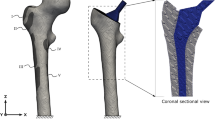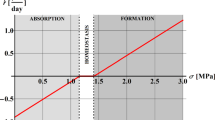Abstract
The development of computational models to describe bone behavior when prosthetic devices are used has gained tremendous importance. In particular, computational modeling for bone growth and resorption processes can be a useful tool to determine the implant success or failure. We present a model for investigating bone density growth for healthy and prosthetic femur with a total hip arthroplasty. The model, which is based on a continuum theory for density growth and remodeling in biological materials that accounts for the coupling between biological and mechanical effects, is implemented in COMSOL Multiphysics and two simulation examples are presented. In the first example, where mechanical loads due to daily physical activities are considered, it is shown that higher stress zones (in prosthetic femur mid-diaphysis of about 46 MPa) and lower stress zones (in prosthetic femur neck of about 28 MPa) are candidates for bone growth and resorption zones, respectively. In addition, it is shown that higher and lower stress levels in these zones may lead to possible periprosthetic fractures (bone mid-diaphysis overloaded in 7–10 MPa post-operatively) and eventually to implant aseptic loosening due to resorption (bone femoral neck unloaded in 13–17 MPa post-operatively). In the second example, where the mechanical load corresponds to the average of the loads considered previously, the obtained results for bone density are in good agreement with real bone density distribution in the proximal femur, which illustrates the model capability to locate bone density growth zones (of about 1615 \(\mathrm {kg/{m}^{3}}\) in the mid-diaphysis) and bone density resorption zones (of about 1259 \(\mathrm {kg/{m}^{3}}\) in the neck) due to mechanical loads for the femur post-operative condition after a total hip arthroplasty surgical procedure.





Similar content being viewed by others
Notes
Lagrangian quadratic: \(Lag_{k}(\text {T})\), \(k=2\), being k the polynomial degree of the element shape function and \(\text {T}\) the mesh type: triangular in this case [17]
References
Ambrosi D, Ateshian G, Arruda E, Cowin S, Dumais J, Goriely A, Holzapfel G, Humphrey J, Kemkemer R, Kuhl E, Olberding J, Taber L, Garikipati K (2011) Perspectives on biological growth and remodeling. J Mech Phys Solids 59(4):863–883
Andreaus UA, Colloca M, Toscano A (2008) Mechanical behaviour of a prosthesized human femur: a comparative analysis between walking and stair climbing by using the finite element method. Biophys Bioeng Lett 1(3)
Ashman RB, Rho JY (1988) Elastic modulus of trabecular bone material. J Biomech 21(3):177–181
Avval PT, Samiezadeh S, Klika V, Bougherara H (2015) Investigating stress shielding spanned by biomimetic polymer-composite vs. metallic hip stem: a computational study using mechano-biochemical model. J Mech Behav Biomed Mater 41:56–67
Bergmann G, Orthoload (eds) (2009) Charit\(\acute{\rm e}\) Universitaetsmedizin Berlin (2008). http://www.OrthoLoad.com. Accessed 1 Feb 2009
Bergmann G, Graichen F, Rohlmann A, Bender A, Heinlein B, Duda GN, Heller MO, Morlock MM (2010) Realistic loads for testing hip implants. Bio Med Mater Eng 20(2):65–75
Blanco JO, Madrigal MR, Calas H, Moreno E, Salas LL, Palomares E (2013) Modelación y Simulación de Sistemas Biomecánicos Acoplados Utilizando el Método de Elementos Finitos. Aplicaciones en Ortopedia. Springer, Berlin Heidelberg, pp 619–622
Bougherara H, Zdero R, Shah S, Miric M, Papini M, Zalzal P, Schemitsch EH (2010) A biomechanical assessment of modular and monoblock revision hip implants using fe analysis and strain gage measurements. J Orthop Surg Res 5(1):34
Carter D, Beaupré G (2007) Skeletal function and form: mechanobiology of skeletal development, aging, and regeneration. Cambridge University Press, Cambridge
Carter D, der Meulen MV, Beaupré G (1996) Mechanical factors in bone growth and development. Bone 18(1, Supplement 1), S5–S10. In: Proceedings of the International Symposium on Physical Loading, Exercise, and Bone
Carter DR (1987) Mechanical loading history and skeletal biology. J Biomech 20(11–12):1095–1109
Carter DR, Fyhrie DP, Whalen RT (1987) Trabecular bone density and loading history: regulation of connective tissuebiology by mechanical energy. J Biomech 20(8):785–794
Carter DR, Hayes WC (1977) The compressive behavior of bone as a two-phase porous structure. J Bone Jt Surg 59(7):954–962
Chandran P, Azzabi M, Miles J, Andrews M, Bradley J (2010) Furlong hydroxyapatite-coated hip prosthesis vs the charnley cemented hip prosthesis. J Arthroplasty 25(1):52–57
Chen CM, Tsai WC, Lin SC, Tseng CS (2014) Effects of stemmed and nonstemmed hip replacement on stress distribution of proximal femur and implant. BMC Musculoskelet Disord 15:312
Chung J, Hulbert GM (1993) A time integration algorithm for structural dynamics with improved numerical dissipation: the generalized-\(\alpha\) method. J Appl Mech 60(2):371–375
COMSOL: Comsol multiphysics (2013) Reference manual. 2013 version 4.4, Comsol
Cowin S, Doty S (2007) Tissue mechanics. Springer, Berlin
Cowin SC, Hegedus DH (1975) Bone remodeling I: theory of adaptive elasticity. J Elast 6(3):313–326
Doblaré M, Garcia J, Gomez M (2004) Modelling bone tissue fracture and healing: a review. Eng Fract Mech 71(1314):1809–1840
Drexler M, Dwyer T, Chakravertty R, Backstein D, Gross AE, Safir O (2014) The outcome of modified extended trochanteric osteotomy in revision THA for vancouver b2/b3 periprosthetic fractures of the femur. J Arthroplasty 29(8):1598–1604
Duda GN, Heller M, Albinger J, Schulz O, Schneider E, Claes L (1998) Influence of muscle forces on femoral strain distribution. J Biomech 31(9):841–846
Epstein M, Maugin GA (2000) Thermomechanics of volumetric growth in uniform bodies. Int J Plast 16(7–8):951–978
Erdemir A, Guess TM, Halloran J, Tadepalli SC, Morrison TM (2012) Considerations for reporting finite element analysis studies in biomechanics. J Biomech 45(4):625–633
Fleischman AN, Chen AF (2015) Periprosthetic fractures around the femoral stem: overcoming challenges and avoiding pitfalls. Ann Transl Med 3(16):234
Frenzel S, Vécsei V, Negrin L (2015) Periprosthetic femoral fractures incidence, classification problems and the proposal of a modified classification scheme. Int Orthop 39(10):1909–1920
Gabbar OA, Rajan RA, Londhe S, Hyde ID (2008) Ten- to twelve-year follow-up of the furlong hydroxyapatite-coated femoral stem and threaded acetabular cup in patients younger than 65 years. J Arthroplasty 23(3):413–417
Gibson LJ, Ashby MF (1982) The mechanics of three-dimensional cellular materials. Proc R Soc Lond A Math Phys Sci 382:43–59
Goldstein SA (1987) The mechanical properties of trabecular bone: dependence on anatomic location and function. J Biomech 20(1112):1055–1061
Harrigan TP, Hamilton JJ (1993) Finite element simulation of adaptive bone remodelling: a stability criterion and a time stepping method. Int J Numer Method Eng 36(5):837–854
Huiskes R, Weinans H, Grootenboer HJ, Dalstra M, Fudala B, Slooff TJ (1987) Adaptive bone-remodeling theory applied to prosthetic-design analysis. J Biomech 20(11–12):1135–1150
Husmann O, Rubin PJ, Leyvraz PF, de Roguin B, Argenson JN (1997) Three-dimensional morphology of the proximal femur. J Arthroplasty 12(4):444–450
Iorio R, Robb WJ, Healy WL, Berry DJ, Hozack WJ, Kyle RF, Lewallen DG, Trousdale RT, Jiranek WA, Stamos VP, Parsley BS (2008) Orthopaedic surgeon workforce and volume assessment for total hip and knee replacement in the united states: preparing for an epidemic. J Bone Jt Surg 90(7):1598–1605
Jacobs CR, Levenston ME, Beaupré GS, Simo JC, Carter DR (1995) Numerical instabilities in bone remodeling simulations: the advantages of a node-based finite element approach. J Biomech 28(4):449–459
Jones GW, Chapman SJ (2012) Modeling growth in biological materials. SIAM Rev 54(1):52–118
Jonkers I, Sauwen N, Lenaerts G, Mulier M, der Perre GV, Jaecques S (2008) Relation between subject-specific hip joint loading, stress distribution in the proximal femur and bone mineral density changes after total hip replacement. J Biomech 41(16):3405–3413
Keyak JH, Rossi SA (2000) Prediction of femoral fracture load using finite element models: an examination of stress- and strain-based failure theories. J Biomech 33(2):209–214
Kuhl E (2014) Growing matter: a review of growth in living systems. J Mech Behav Biomed Mater 29(1751–6161):529–543
Kuhl E, Balle F (2005) Computational modeling of hip replacement surgery: total hip replacement vs. hip resurfacing. Tech Mech 25(2):107–114
Kuhl E, Menzel A, Steinmann P (2003) Computational modeling of growth. Comput Mech 32(1–2):71–88
Kuhl E, Steinmann P (2003) Mass and volume specific views on thermodynamics for open systems. Proc R Soc Lond Ser A Math Phys Eng Sci 459(2038):2547–2568
Kuhl E, Steinmann P (2003) Theory and numerics of geometrically non-linear open system mechanics. Int J Numer Method Eng 58(11):1593–1615
Kurtz S, Ong K, Lau E, Mowa TF, Halpern M (2007) Projections of primary and revision hip and knee arthroplasty in the united states from 2005 to 2030. J Bone Jt Surg Ser A 89(4):780–785
Lubarda V, Hoger A (2002) On the mechanics of solids with a growing mass. Int J Solids Struct 39(18):4627–4664
Malak TT, Beard D, Glyn-Jones S (2014) Total hip arthroplasty: recent advances and controversies. Top Rev Artrhitis Res UK 7(4):1–8
Menzel A, Kuhl E (2012) Frontiers in growth and remodeling. Mech Res Commun 42:1–14
MUMPS: Multifrontal massively parallel sparse direct solver (1996). http://graal.ens-lyon.fr/MUMPS/ (MUMPS Consortium). Accessed 3 April 2015
Natali AN, Meroi EA (1989) A review of the biomechanical properties of bone as a material. J Biomed Eng 11(4):266–276
Niinomi M, Nakai M (2011) Titanium-based biomaterials for preventing stress shielding between implant devices and bone. Int J Biomater 2011(836587):10
Pang H, Shiwalkar A, Madormo C, Taylor R, Andriacchi T, Kuhl E (2012) Computational modeling of bone density profiles in response to gait: a subject-specific approach. Biomech Model Mechanobiol 11(3–4):379–390
Piao C, Wu D, Luo M, Ma H (2014) Stress shielding effects of two prosthetic groups after total hip joint simulation replacement. J Orthop Surg Res 9(1):1–8
Pivec R, Johnson AJ, Mears SC, Mont MA (2012) Hip arthroplasty. The Lancet 380(9855):1768–1777
Prendergrast P (1997) Finite element models in tissue mechanics and orthopaedic implant design. Clin Biomech 12(6):343–366
Rodriguez E, Hoger A, McCulloch D (1994) Stress dependent finite growth in soft elastic tissues. J Biomech 27(4):445–467
Samiezadeh S, Avval PT, Fawaz Z, Bougherara H (2014) Biomechanical assessment of composite versus metallic intramedullary nailing system in femoral shaft fractures: A finite element study. Clin Biomech 29(7):803–810
Smith AJ, Dieppe P, Vernon K, Porter M, Blom AW (2012) Failure rates of stemmed metal-on-metal hip replacements: analysis of data from the national joint registry of england and wales. The Lancet 379(9822):1199–1204
Speirs AD, Heller MO, Duda GN, Taylor WR (2007) Physiologically based boundary conditions in finite element modelling. J Biomech 40(10):2318–2323
Taber LA (1995) Biomechanics of growth, remodeling, and morphogenesis. Appl Mech Rev 48(8):487–545
Taddei F, Cristofolini L, Martelli S, Gill H, Viceconti M (2006) Subject-specific finite element models of long bones: an in vitro evaluation of the overall accuracy. J Biomech 39(13):2457–2467
Taylor M, Prendergast PJ (2015) Four decades of finite element analysis of orthopaedic devices: where are we now and what are the opportunities? J Biomech 48(5):767–778 (In Memory of Rik Huiskes)
Waffenschmidt T, Menzel A, Kuhl E (2012) Anisotropic density growth of bone. A computational micro-sphere approach. Int J Solid Struct 49(14):1928–1946
Wagner DW, Divringi K, Ozcan C, Grujicic M, Pandurangan B, Grujicic A (2010) Combined musculoskeletal dynamics/structural finite element analysis of femur physiological loads during walking. Multidiscip Model Mater Struct 6(4):417–437
Weinans H, Huiskes R, Grootenboer HJ (1992) An approach for time-dependent bone modeling and remodeling-theoretical development. J Orthop Res 8(5):651–661
Wolff J, Maquet P, Furlong R (1986) The law of bone remodelling. Springer, Berlin
Wong J, Bronzino J (2007) Biomaterials. Taylor & Francis, Boca Raton
Acknowledgements
The authors gratefully acknowledge the financial support provided by CNPQ under Grant (870068/1997.0) and CAPES PNPD (31001017030D4).
Author information
Authors and Affiliations
Corresponding author
Ethics declarations
Conflict of interest
The authors declare no conflict of financial interest in the work presented as well as any kind of involvements that might raise the question of bias.
Additional information
Technical Editor: Estevam Barbosa Las Casas.
Rights and permissions
About this article
Cite this article
O’Connor, J., Borges, L.A., Duda, F.P. et al. Bone density growth and the biomechanics of healthy and prosthetic femur. J Braz. Soc. Mech. Sci. Eng. 39, 3743–3756 (2017). https://doi.org/10.1007/s40430-017-0874-x
Received:
Accepted:
Published:
Issue Date:
DOI: https://doi.org/10.1007/s40430-017-0874-x




